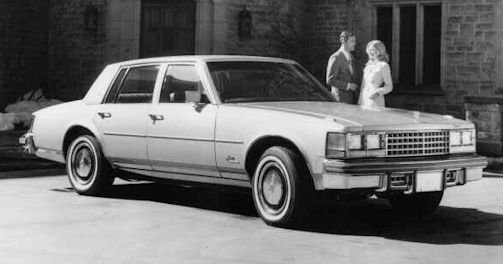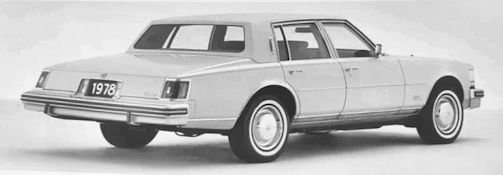Cadillac Seville First generation
 |
|
|
Model years |
1976 to 1979 |
|
Class |
Luxury Car |
|
Assembly |
Detroit, Iran |
|
Designer |
Bill Mitchell |
|
Body style |
4-door sedan |
|
Layout |
FR layout |
|
Platform |
K-body |
|
Engine |
350 cu in (5.7 L) V8 |
|
Transmission |
3-speed TH-400 Turbo-Hydramatic automatic |
|
Wheelbase |
114.3 in (2,900 mm) |
|
Length |
204.0 in (5,180 mm) |
|
Width |
71.8 in (1,820 mm) |
|
Height |
1975–77: 54.7 in (1,390 mm) |
The first series of the Cadillac Seville was introduced in May 1975. With her, General Motors responded to the increasing interest of American customers in compact luxury vehicles. The external reason for this was the oil crisis at the beginning of the 1970s. It had led in the US to a move towards smaller, fuel-efficient vehicles, which were imported for lack of domestic alternatives primarily from Europe and Japan.
The 1976 Cadillac Seville introduced on May 1st,broadening the Cadillac line up to be dimensionally and operationally competitive With all and foreign luxury automobiles. The international Size Seville is 27" Shorter' B" almost identical in height and about 1,000 pounds less than the 1976 Cadillac Sedan de Ville. The classic. uncluttered Seville styling features a traditional Cadillac cross-hatch grille, rectangular headlamps, and simple rear design With large wraparound tail lamps. The distinctive profile and roof line is accented by large wheel openings. powered by a 350 CID (5.7 Litre)Electronic Fuel injected engine.
Initially, compact import models were only successful in the lower price segment; Increasingly, however, importers managed to occupy even the high-priced sector. Here it was primarily German manufacturers who achieved success with technically high-quality vehicles such as the Mercedes-Benz and the BMW E3. At first, American manufacturers had nothing to oppose. General Motors was the first of the big three American automakers to recognize a potential domestic model market. This gap was filled with the 1975 Cadillac Seville, which was 50 cm shorter and almost 450 kg lighter than the full-size models of the Deville series and in its dimensions thus approximately the US version of the contemporary S-Class of Mercedes -Benz corresponded. The Seville, despite its very high price, was able to establish itself well on the American market without, of course, outdoing the German import vehicles.
Two years later, Ford and Chrysler followed suit with the Lincoln Versailles and LeBaron, respectively. However, they were not nearly as successful as the Cadillac Seville. This was mainly due to the fact that both the Lincoln and the Chrysler were only slightly modified middle-class models, whose relationship to the basic models was readily apparent. The Cadillac Seville, however, was in any case externally completely independent model, which seemed to have no discernible relations with cheaper Group vehicles.
The name Seville goes back to the Spanish city of Seville. Cadillac had already used this term from 1956 to 1960 as additional designation for particularly high-quality hardtop coupes, which had been marketed as Eldorado Seville. General Motors had originally considered naming Cadillac's small vehicle "Leland" (named after Henry Martin Leland, the founder of the brand). However, this was soon abandoned, as it was feared that many of the younger buyers would not be able to assign the name or would instead create an unwanted association with the British car manufacturer British Leyland.
It was also considered reviving the name LaSalle, under which the cheaper models Cadillacs were marketed in the 1930s and 1940s. This idea was not implemented; allegedly the name LaSalle had the "image of a loser"
Model History
When developing the Cadillac Seville, the engineers had the requirement to use existing in-house components. Initially, it was considered the "baby Cadillac" from the Opel Diplomat derive, which was driven in its highest quality equipment level by an American eight-cylinder engine. For cost reasons, this solution could therefore not be realized. Instead, the X-platform was used by General Motors as the base since 1968 in vehicles such as the Chevrolet Nova was used. This base has been extensively revised; in particular, the suspension and brakes were adjusted in view of the small Cadillac should compete with German vehicles.
During tests, observers came to the conclusion that the Seville "best driving behaviour of a Cadillac since time immemorial" to the day.The drive initially served a 5.7-liter (350 cubic inch) large eight-cylinder engine, which was supplied by Oldsmobile. The engine was equipped as standard with an electronic fuel injection and made 180 hp.
With the beginning of the model year 1978, an equally large diesel engine was available as an alternative, which was also produced by Oldsmobile and delivered 120 hp. The engine suffered from significant reliability problems and was rarely ordered. The power transmission was standard by a three-speed automatic.
Unlike the case of the later competitors of Lincoln and Chrysler, the Seville received a completely independent body. The lines were in contrast to the sweeping forms of the Deville series straight and straightforward. The typical grille with chrome grilles ("Eggcrate-grille" or egg-box grill) made a reference to the Cadillac brand. For the first two years, the Seville was available exclusively with a vinyl-covered roof. The cover was intended to conceal a welded seam in the metal structure resulting from the fact that the roof was made up of two separately manufactured components: the front roof part corresponded to the low-priced models of the X-Bodies, while the rear roof part was manufactured exclusively for the Seville. Since many customers wanted to distance themselves from the vinyl roof,
The Cadillac Seville was among the most expensive automobiles of American production. At his presentation, the price of the basic version was $ 12,500. He was - with the exception of the long-wheelbase Cadillac Seventy-Five sedan - the most expensive Cadillac. This maintained this position until the end of his production.
Over the years, in addition to the basic version of some special models, which were sold at far higher prices:
- This includes the Cadillac Seville Elegant, which was offered from 1978. It was characterized by an almost complete standard equipment and was externally recognizable by a two-colour finish.
- In 1979, Cadillac also offered a Seville Gucci, which had a high-quality leather interior and was externally visible on a vinyl cover, which extends over the C-pillar. The remodelling work was subsequently carried out on the order of a Miami-based company. The price for the Seville Gucci was $ 23,000. He was thus $ 9,000 more expensive than the Cadillac Seville in its basic version.
Distribution
The first series of the Cadillac Seville was a successful automobile. Although the production reached in any year even close to the level of full-size models Deville and Fleetwood Brougham. However, the Seville was nearly 50 percent more expensive than the standard models. In five years, Cadillac produced over 215,000 copies of the Seville.
In the first year of production, 16,355 vehicles were produced, and in 1976, 43,772 vehicles were produced. In 1977 Cadillac was able to produce 45,060 Seville’s. The most successful model year was 1978, when nearly 57,000 vehicles were produced. In the last year of production, another 53,487 vehicles were produced.
In Iran, the model was assembled from 1977 to 1980 by the company Iran General Motors under the model’s name Cadillac Civil.

Technical
-
Production
Year
Total
1975
16,355
1976
43,772
1977
45,060
1978
56,985
1979
53,487
Engines
Year
Engine
Power
1976–1979
5.7 L Oldsmobile V8
180 hp (134 kW)
1978–1979
5.7 L LF9 Diesel V8
105 hp (78 kW)
